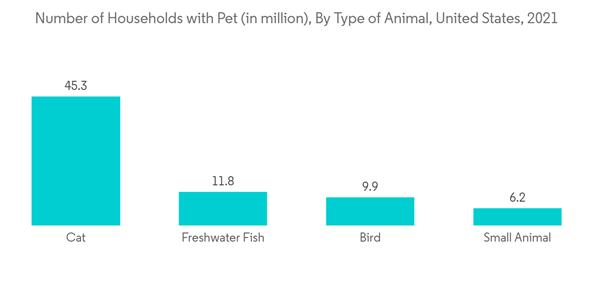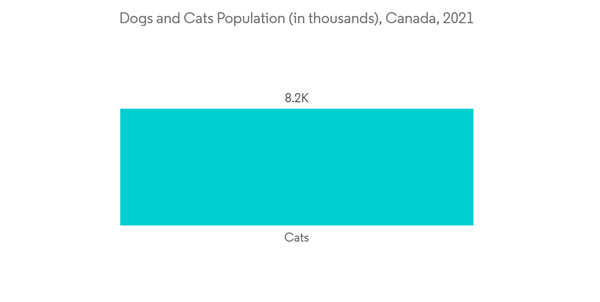The outbreak of the COVID-19 pandemic impacted the market. According to a research article published in the Canadian Veterinary Journal in April 2021, the pandemic took a toll on the veterinary healthcare industry. In 2021, there was an increase in the expenses for veterinary practices by 5%, requiring an even higher increase in professional fees. Furthermore, another article presented in the journal, Frontiers in Veterinary Science in February 2021 discussed dog owners' fears and concerns about veterinary care and obtainment of pet care products and food during the lockdown phase of the pandemic to be better prepared to address these concerns during the pandemic and in the future. The study indicated that, like many other professions, veterinarians were significantly impacted by the onset of COVID-19. Standard practices such as routine animal checkups and surgeries were disrupted, and veterinary clinics and hospitals had to quickly modify standard protocols to serve their clients and patients safely. However, with the ease of restrictions and declining cases of COVID-19, the market started to gain traction and is expected to maintain an upward trend over the forecast period.
The advanced technology leading to innovations in animal healthcare, increasing initiatives by governments and animal welfare associations, and increasing productivity at the risk of emerging zoonosis are the major drivers for the market. For instance, an article published by the Government of Canada on reportable diseases in terrestrial animals updated in February 2021 listed several diseases that affect the animals, including companion animals in the region. The large list of diseases includes equine infectious anemia, equine piroplasmosis, Newcastle disease, pullorum disease, and vesicular stomatitis among others. The increase in the occurrence of diseases among companion animals in the region and the requirement of associated medications will provide a lucrative growth of the North America veterinary healthcare market over the forecast period. In addition, the development of preventive diagnostic tools is also expected to contribute to market growth. For instance, in April 2021, AntechDiagnostics, part of Mars Veterinary Health, released new data that shows that all cats from a retrospective review of 730,000 veterinary visits received improved preventive care. The data shows that the predictive diagnostic tool increased veterinary visits by as much as 31.0%.
Increasing pet ownership and animal expenditure is also anticipated to drive market growth. For instance, according to the American Pet Products Association's 2021-2022 National Pet Owners Survey, around 69.0 million Americans owned a dog, 45.3 million owned cats, 11.8 owned freshwater fish, 9.9 million owned birds, 6.2 million owned small animals, 5.7 million owned reptiles, 3.5 million owned horses, and 2.9 million owned saltwater fish. Similarly, according to a report published by the American Pet Products Association's National Pet Owners Surveys in 2022, the United States pet industry expenditure accounted for USD 123.6 billion in 2021. Moreover, as per a report published by the North American Pet Health Insurance Association (NAPHIA) in 2021, the pet insurance sector of North America exceeded USD 2.83 billion by the end of 2021, and the industry witnessed a growth of more than double over the past four years. It also reported total premium volume for pet insurance in the United States was around USD 2.6 billion in 2021. The total number of pets insured in the United States at the end of the year 2021 was 3.9 million, which is an increase of around 28% from 2020.
While growth is expected, the lack of veterinarians and the high costs associated with animal healthcare may hinder market growth over the forecast period.
North America Veterinary Healthcare Market Trends
The Vaccine Segment is Anticipated to Witness Considerable Growth Over the Forecast Period
With increasing government initiatives and effective and unique vaccination programs in the country, the vaccine segment is anticipated to grow over the forecast period. Vaccinating animals to prevent common diseases is a practice that must be followed by companion animal/ pet owners. In North America, vaccines are given by veterinarians as part of routine visits. For instance, according to Health Canada data updated in February 2022, if any person is traveling with a pet or planning to import an animal to Canada, they will need the right paperwork at the border to meet Canada's import requirements. In addition, if proper vaccination data or paperwork is missing, the owners are not allowed to take their companion animal to the Canadian border. These strict government initiatives and regulations are increasing awareness about pet vaccination for diseases such as rabies, thereby driving the segment growth.The product launches by the key players are also anticipated to propel the segment growth over the forecast period. For instance, in May 2022, Ceva expanded its oral rabies vaccine portfolio with the acquisition of Canadian firm Artemis Technologies, Inc. With this acquisition, Ceva expanded its presence in the segment to North America. Similarly, in January 2022, rabies was identified in a dog in Ontario that was imported from Iran. That dog developed neurological signs that progressed rapidly over six days despite medical treatment. These cases each led to extensive investigations involving multiple public health units. Toronto Public Health issued a press release to locate one person who had contact with the second dog. A total of 51 individuals received rabies post-exposure prophylaxis (PEP) as a result of contact with the two dogs. Both dogs had been vaccinated for rabies in Iran before importation with a vaccine that was not licensed in Canada. Furthermore, in September 2021, the Canadian Animal Health Institute (CAHI) launched its 2021 World Rabies Day Initiative for Remote Indigenous Communities in Canada to improve both animal health and public health in these communities by supporting increased access to canine rabies vaccinations in areas where veterinary services are not readily available.
The Dogs and Cats Segment is Anticipated to Witness Significant Growth Over the Forecast Period
Dogs are the most adopted companion animals, and as more dogs are being adopted, the awareness about zoonotic diseases is also improving, driving the growth of the segment. In September 2022, the Canadian Animal Health Institute (CAHI) shared the 2022 Pet Population Survey and as per the survey, Canada's dog and cat populations continued to grow, increasing from 7.7 million to 7.9 million for dogs and from 8.1 million to 8.5 million for cats. The survey also stated that in the dog and cat populations, the annual dog medicalization rate remained stable at 86%, while the multi-year trend of increasing feline medicalization rates continued. Thus, such instances are expected to propel the segment growth over the forecast period.Key product launches, high concentration of market players or manufacturers' presence, acquisitions and partnerships among major players, and increasing pet adoption in the United States are some of the factors driving the growth of the segment. For instance, according to the National Pet Owners Survey 2021-2022, conducted by the American Pet Products Association (APPA), around 70.0% of United States households owned a pet, which equates to 90.5 million homes, including 45.3 million cats and 69.0 million dogs. Furthermore, according to the U.S. Department of Agriculture, there were 103.0 million cattle and 32.1 million beef cows in the U.S. in July 2020, and this number is expected to grow substantially in the coming years. Moreover, product approvals for dog and cat treatment are also driving the segment's growth. For instance, in January 2022, Zoetis Inc. announced that the U.S. Food and Drug Administration (FDA) had approved Solensiato to control the pain of osteoarthritis (OA) in cats. It will help to improve mobility, comfort, and the overall well-being of the cats. It requires monthly administration in the veterinary clinic.
North America Veterinary Healthcare Industry Overview
The U.S. and Canada have a developed and well-structured healthcare system. These systems also encourage research and development. These policies encourage global players to enter these countries. As high and increasing demand is met by the presence of global players in the region, the market is further expected to increase.The competitive landscape includes an analysis of a few international as well as local companies which hold the market shares and are well-known, including Boehringer Ingelheim International GmbH, Ceva Holdings Inc. (Ceva Animal Health Inc.), Eli Lilly and Company (Elanco Animal Health), Idexx Laboratories and Merck & Co. Inc. among others.
Additional Benefits:
- The market estimate (ME) sheet in Excel format
- 3 months of analyst support
This product will be delivered within 2 business days.
Table of Contents
Companies Mentioned (Partial List)
A selection of companies mentioned in this report includes, but is not limited to:
- Boehringer Ingelheim GmbH & Co. KG
- Ceva Sante Animale
- Dechra Pharmaceuticals PLC
- Elanco Animal Health Incorporated
- Merck & Co., Inc.
- Neogen Corporation
- Bimeda Inc.
- Zoetis Inc.
- Vetoquinol S.A.
- Idexx Laboratories










